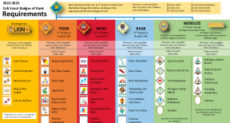 As the old joke goes, meetings are the place where the minutes are kept and the hours are thrown away.
As the old joke goes, meetings are the place where the minutes are kept and the hours are thrown away.
But meeting minutes – the written record of the business conducted – are probably the most important, yet the most ignored, aspect of our meetings. The secretary diligently takes notes – some even record the audio and transcribe it later – writes up the report, prints or e-mails copies, and distributes them to committee members, where they often go unread.
Minutes are an important chronicle of the business of any meeting. As you may recall, the primary purpose of a meeting is to decide who does what by when. If you use your meeting time to plan what your committee will do over the ensuing days and weeks, having a record is valuable in order to know what to do, as well as evaluate when the tasks have been completed.
Difficulties can arise when your committee begins discussing a topic at one meeting, but discussion continues to the next meeting where different people with different ideas might be in attendance. By having a clear description of the discussion at each meeting, these disparate groups can have a means to understand what their counterparts had in mind.
There are many schools of thought about how minutes should be presented. Some go so far as to provide a literal transcript of every word that was said. This is a lot of trouble, as well as difficult to wade through for anyone who cares to. Others just jot a few notes next to the agenda items and report what was decided. The optimal approach is somewhere in between – report what happened, along with the salient points of discussion in enough detail to allow the person who couldn’t attend a reasonably clear idea of who said what.
Minutes are useless, of course, if nobody reads them. One way to encourage reading the minutes is to keep the report concise and easy to digest. Don’t use long paragraphs of small type. Avoid rambling sentences; a reader can forget what the beginning of a Hemingway-esque sentence said by the time he reaches the period. Use proper grammar and spelling, and make sure there are clear divisions between sections. Different agenda items should have their own paragraphs, and meeting sections (Old Business, New Business, etc.) should be set out with bold headlines.
Some other suggestions for recording better minutes:
- Get clarifications. If you don’t understand what was being said, ask to have it repeated. If, after the meeting, you’re not clear on a point, check with the speaker or chair.
- Write it up. Don’t wait until the night before the next month’s meetings to dig out your scratched-out notes and try to put together a coherent report. Try to get the minutes written within a day or two, while it’s fresh in your mind.
- Send it out. For the same reasons, it’s best to distribute the meeting minutes as soon as possible. That way, anyone with questions or corrections can let you know before the next month rolls around.
- Follow up. After sending out minutes, check with important stakeholders to make sure your representation was accurate. By letting them know you’ll be checking back, they’ll be more likely to read the report.
- Wrap it up. Business items can be closed during the meeting, but if the key stakeholders aren’t present, the only record of the item’s status could be the meeting minutes.
You could send out the minutes again prior to the next meeting, and you should have a few printed copies (I would encourage attendees to print out their own copies at home, or bring their laptops or tablets to the meeting). Don’t take up valuable meeting time reading the entire report – just ask for additions or corrections that haven’t already been made.
Finally, be sure to save each month’s minutes in the unit’s permanent records. You may need to refer to them in the future to see what was actually done or said.
When properly curated, minutes are a great way to ensure that the hours devoted to meetings aren’t thrown away.
This post first appeared on Bobwhite Blather.



